This zingy Jaffa Cake traybake is made up of a super light base of vanilla sponge, an sweet and citrusy orange jelly layer, and an indulgent topping of dark chocolate to finish.

It's such a gorgeous combination of flavours and textures, you're sure to want more than one! And despite the cleverly layered effect, this Jaffa Cake traybake is not difficult to make so long as you follow my guide to ensure you nail every element.
You'll start by making the base, which is a fatless sponge made from just sugar, eggs, flour and dash of vanilla. The light texture is achieved not with a raising agent such as baking powder, but by whisking the sugar and eggs together until really thick and mousse-like. It's the same method use to make Swiss roll, so it's a great skill to master.
The orange jelly middle is made simply with fresh orange juice, sugar and gelatine and couldn't be easier to stir together. If you're vegetarian, don't worry as I've included advice on how to use agar agar instead of gelatine.
Finally, the chocolate topping is a simple ganache made from a blend of dark and milk chocolate, butter and a dash of water, melted together until glossy and smooth before being spread on top of the set jelly.
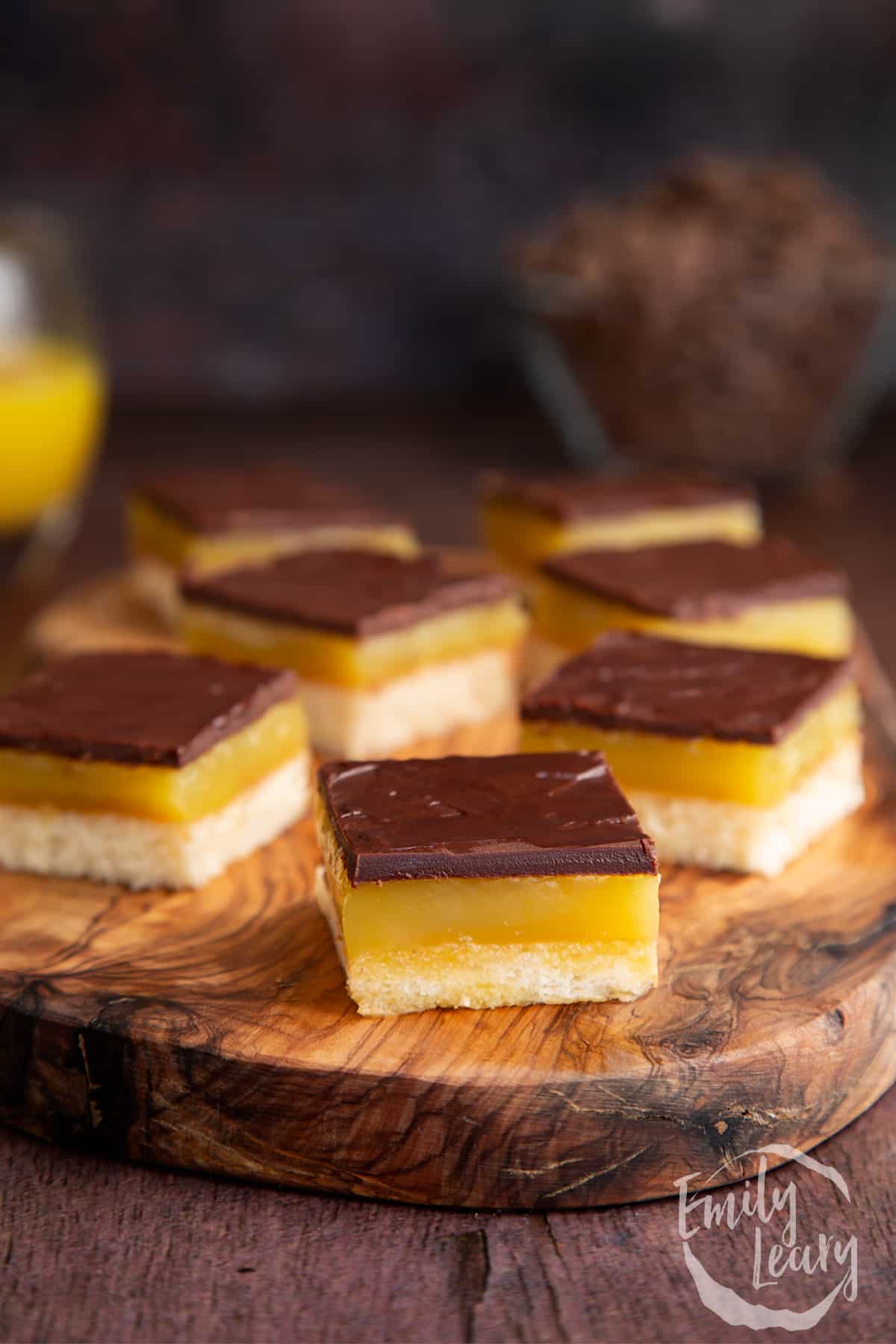
Once sliced into squares, these little Jaffa Cake traybake bits are absolutely irresistible with the super-light sponge, wobbly jelly and creamy-rich chocolate top. You'll love them!
I originally made this recipe as part of a partnership with Dr Oetker way back in 2015, when I shot a series of baking guides with the lovely Stacey Solomon.
I've made tweaks over the years, so here's the newly updated recipe with fresh step-by-step photographs, ready to tempt you into the kitchen!
Ingredients
For the sponge
- 2 medium free range eggs
- 75 g (¼ cup) white caster sugar (superfine sugar)
- 1 tsp vanilla extract
- 50 g (⅓ cup) plain white flour (all purpose flour)
For the orange jelly
- 12 g (4 tsp) powdered gelatine
- 50 g (⅓ cup + 2 tbsp) white caster sugar (superfine sugar)
- 350 ml (1⅓ cup + 2 tbsp) fresh orange juice
To decorate
- 50 g (2 oz) dark chocolate 70% (bittersweet)
- 50 g (2 oz) milk chocolate
- 50 g (½ stick) unsalted butter
Equipment
- Square 20cm (8") nonstick cake tin
- Ruler
- Pencil
- Clingfilm
Instructions
Make the sponge base
Take a piece of baking paper and draw a 20cm (8inch) square onto it using a ruler for accuracy. Flip the paper over (so that you don't get pencil marks on the sponge) and place on a baking tray.
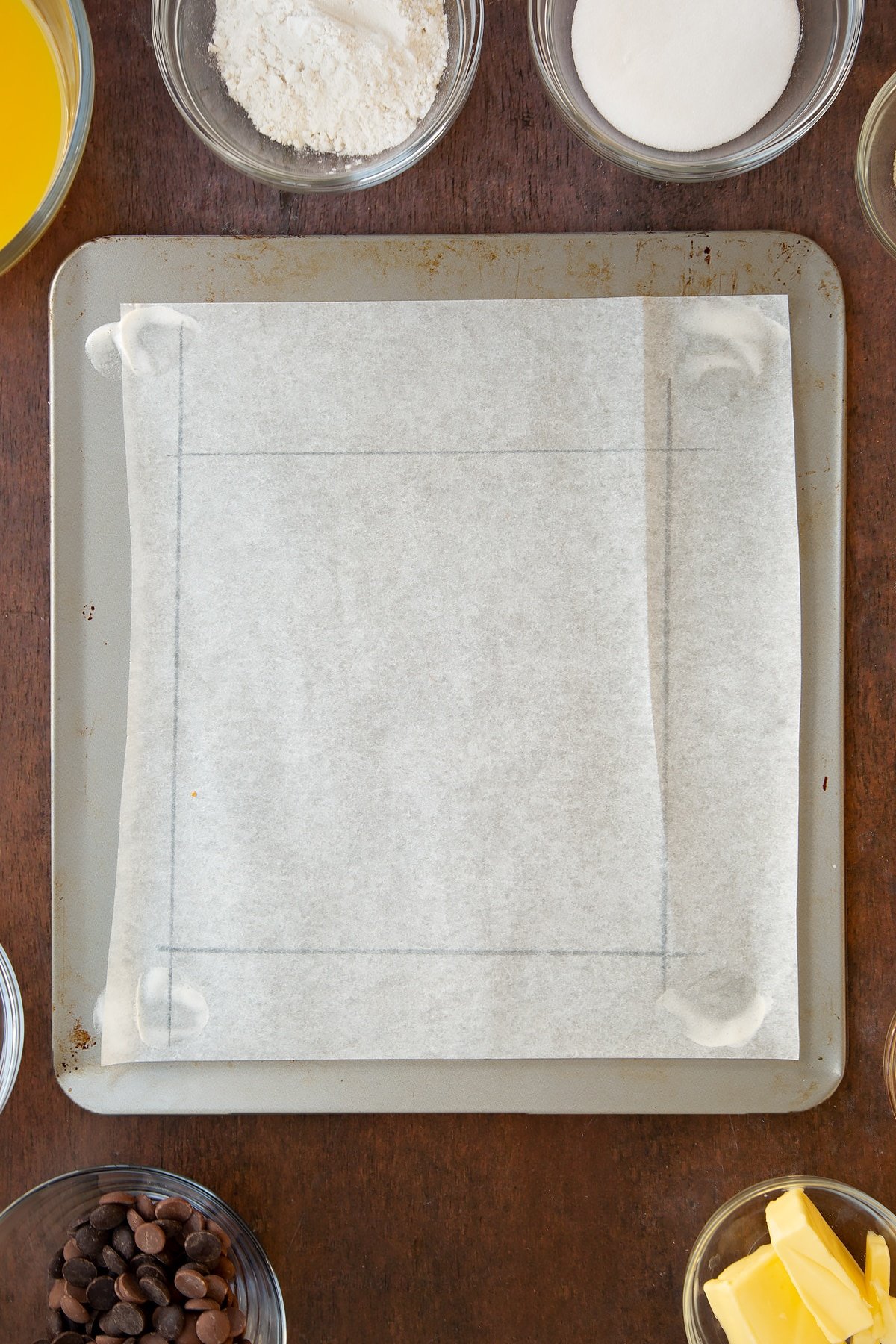
Line an 18cm (7inch) square tin with a double layer of cling film.
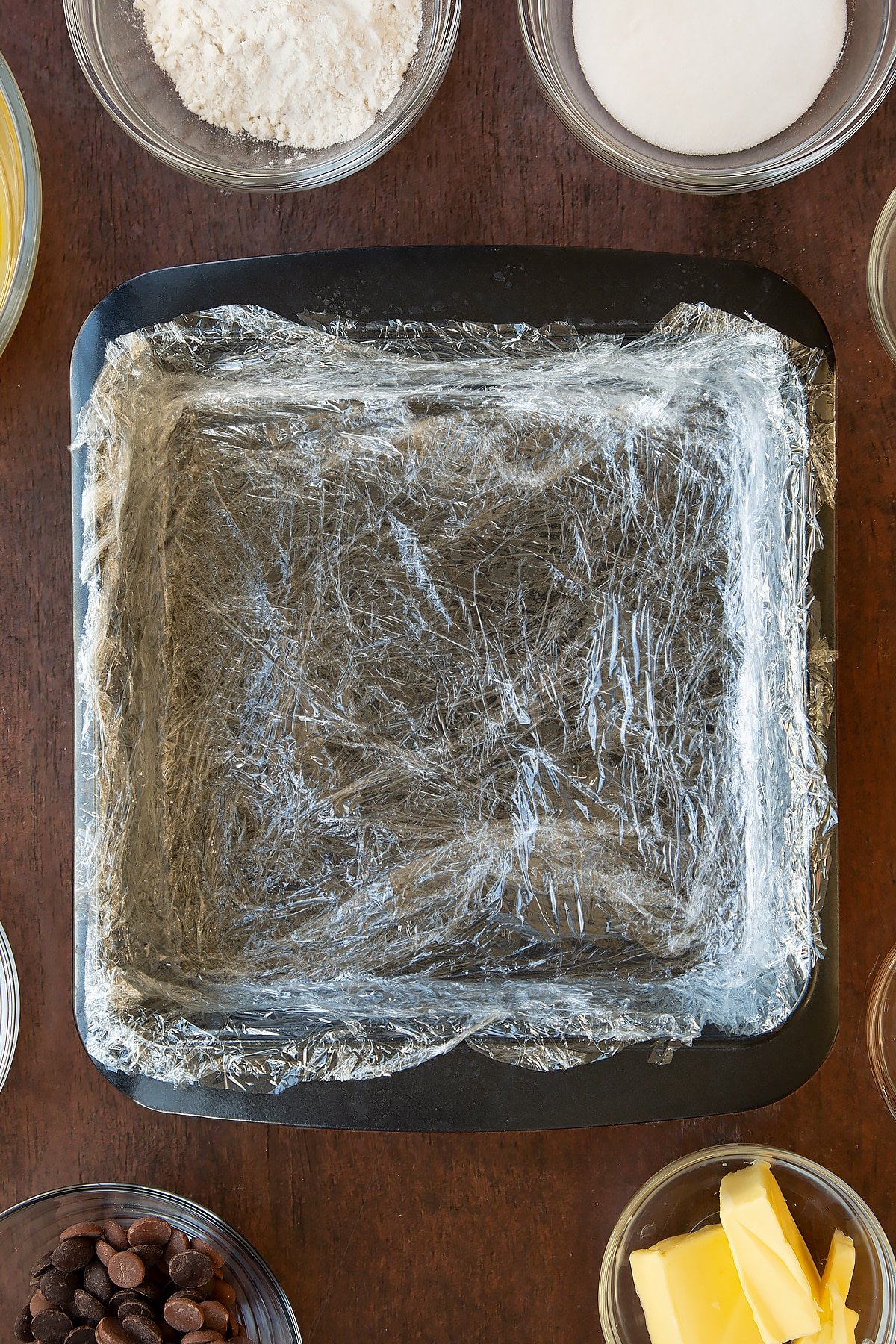
Preheat the oven to 200C (180C fan).
Put the eggs and caster sugar in a large bowl.
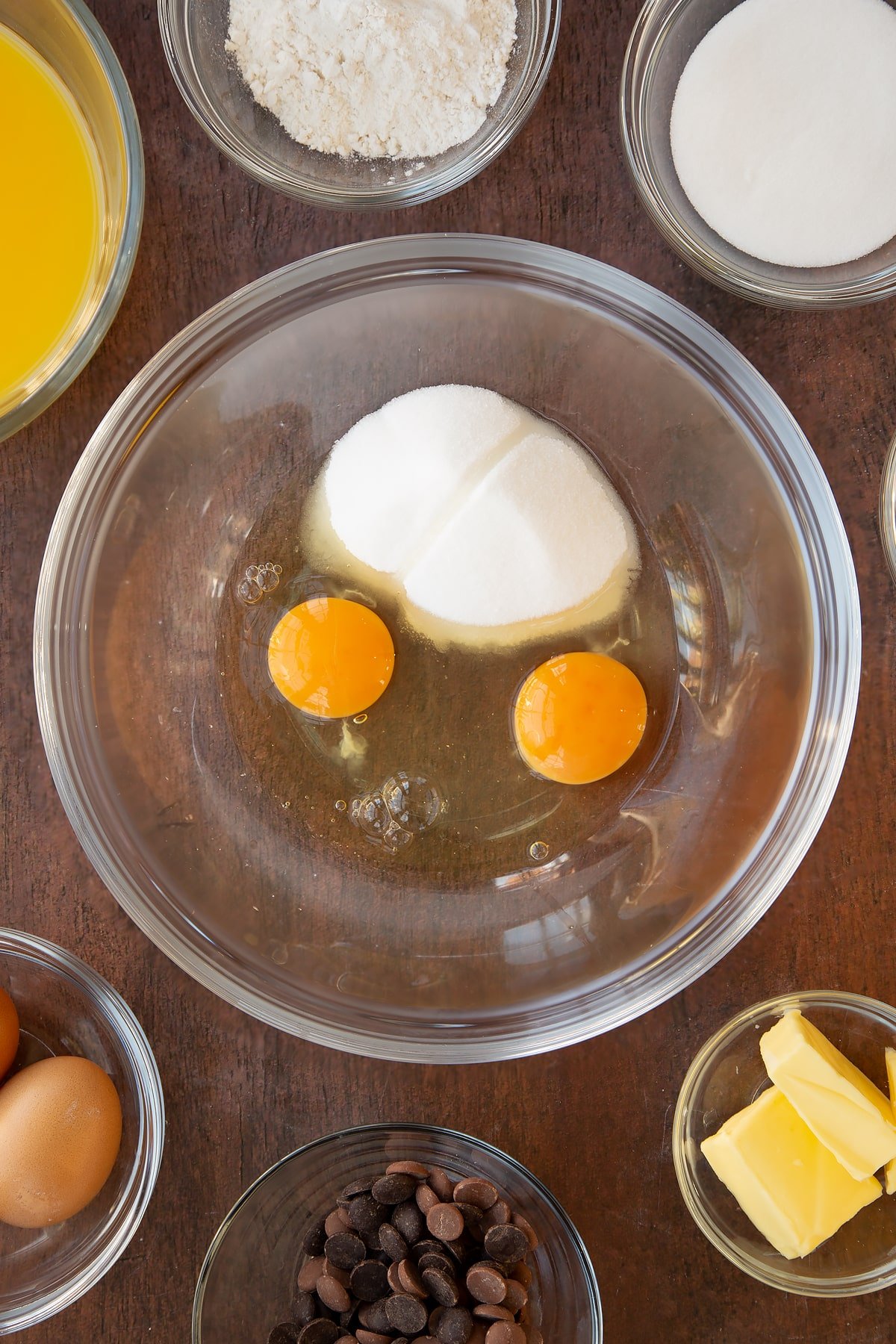
Using electric beaters, whisk them together until thick, pale and creamy. This will take about 5 minutes with electric beaters.
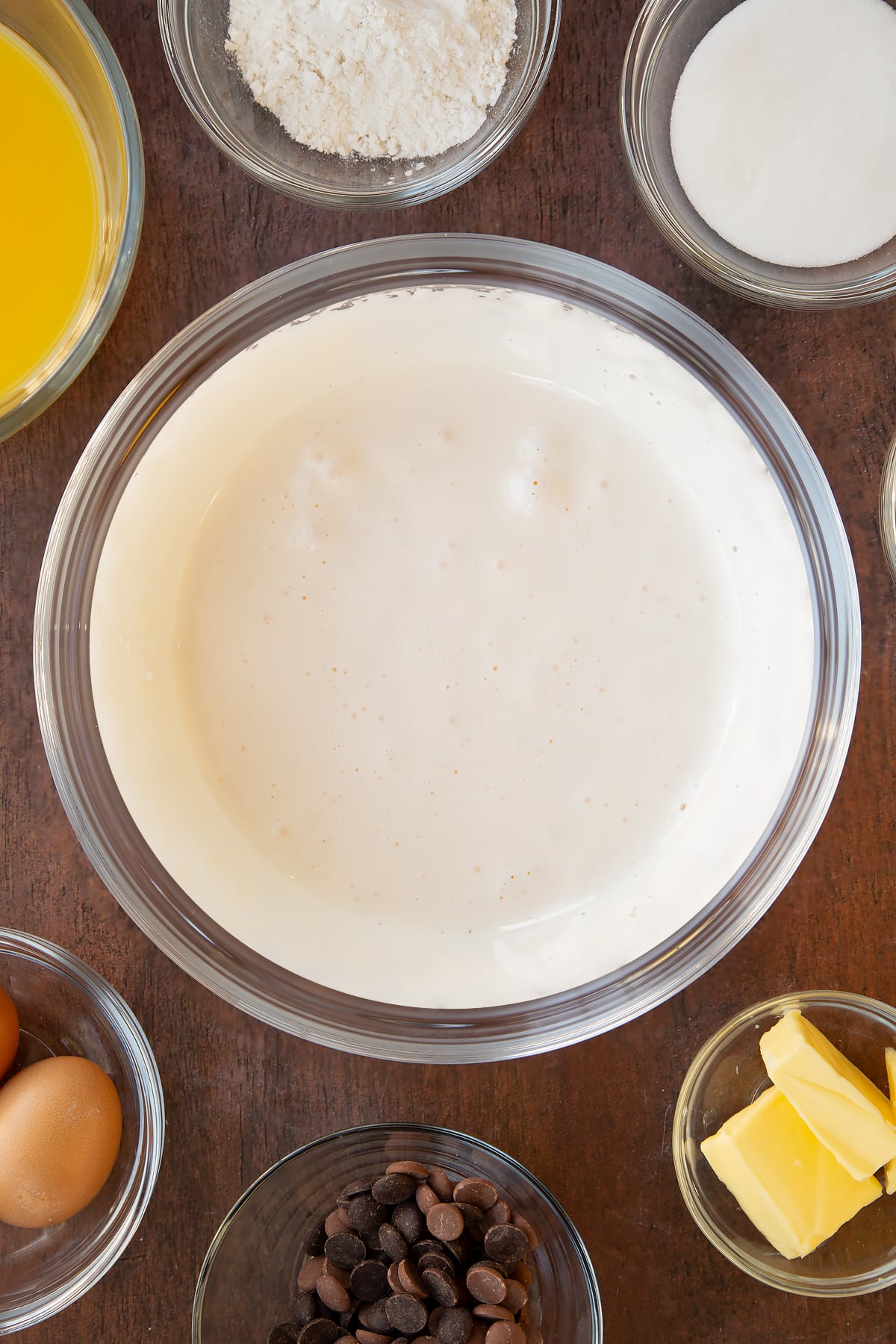
Add the vanilla.
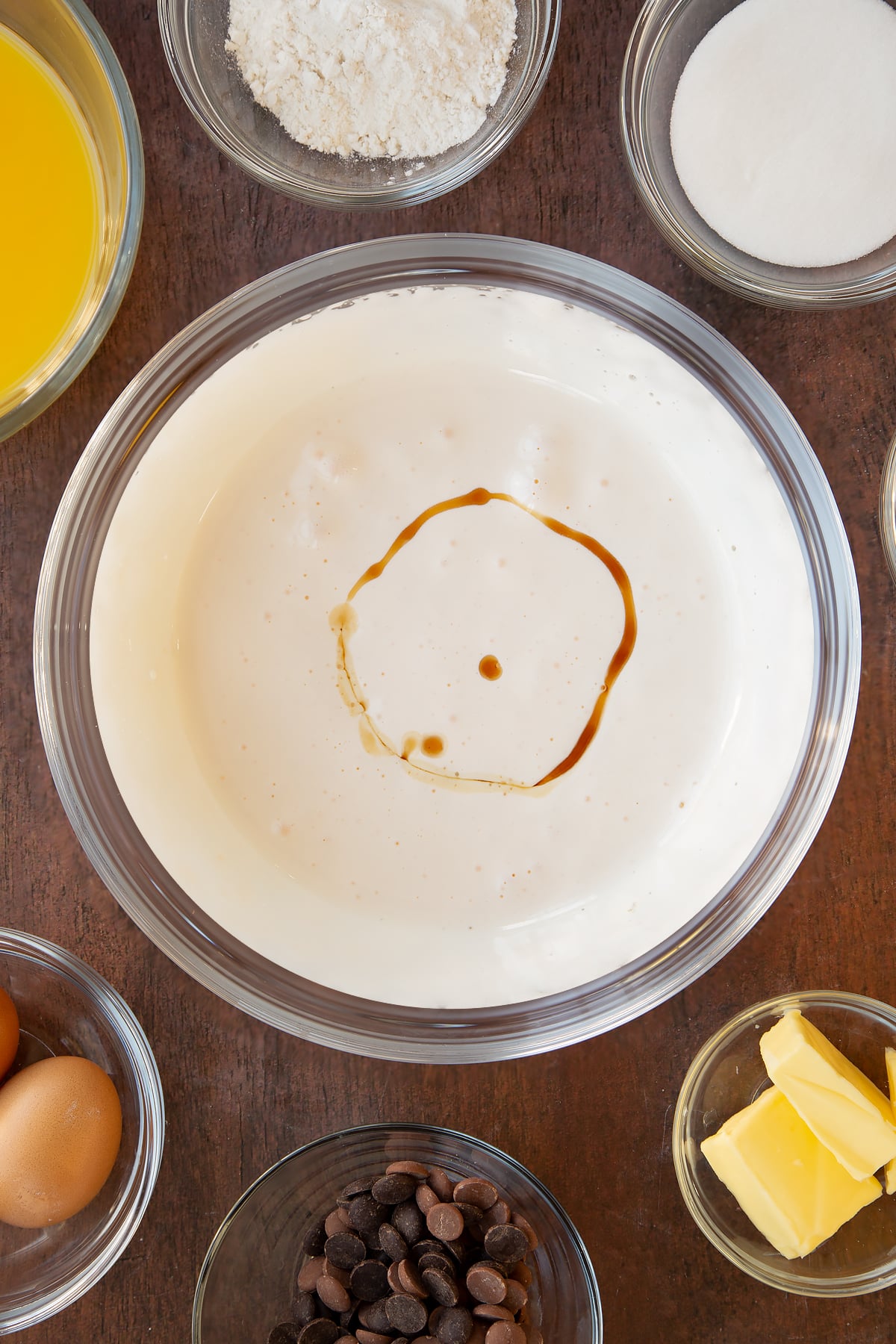
Sift the flour on top.
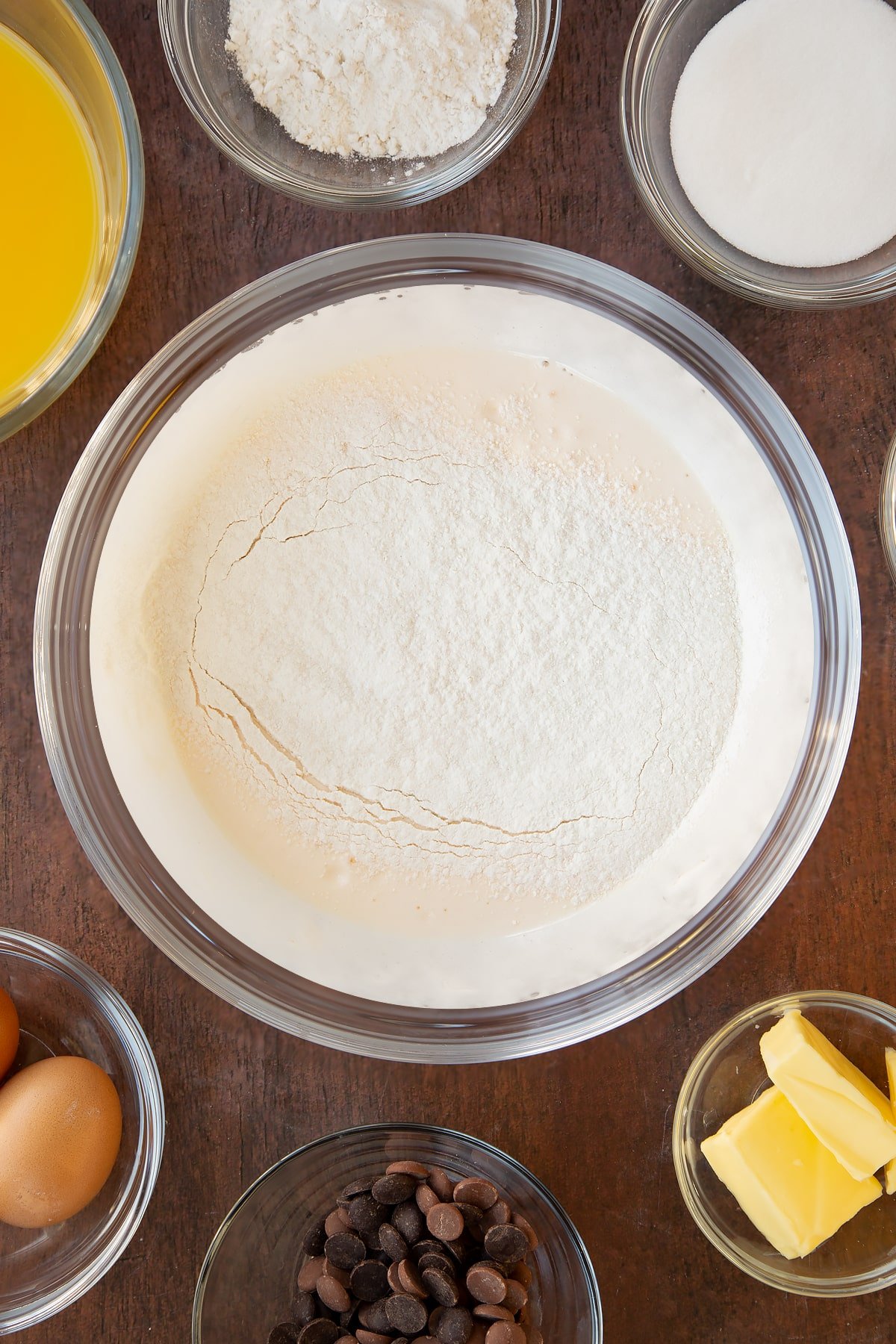
Using a silicone spatula or large metal spoon, fold the flour into the egg mixture.
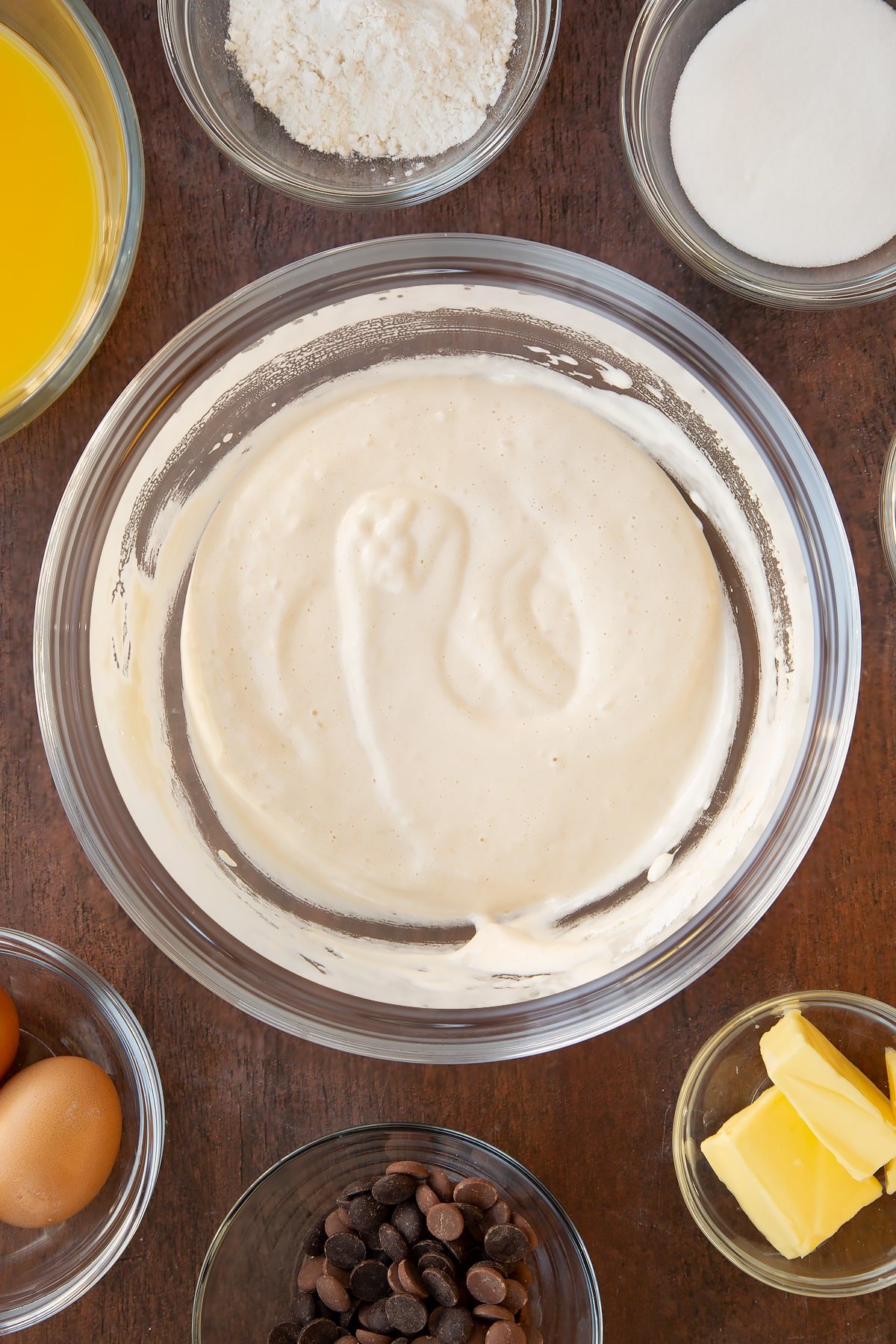
Immediately pour the sponge mix onto the lined baking sheet and gently spread to cover the square you drew.
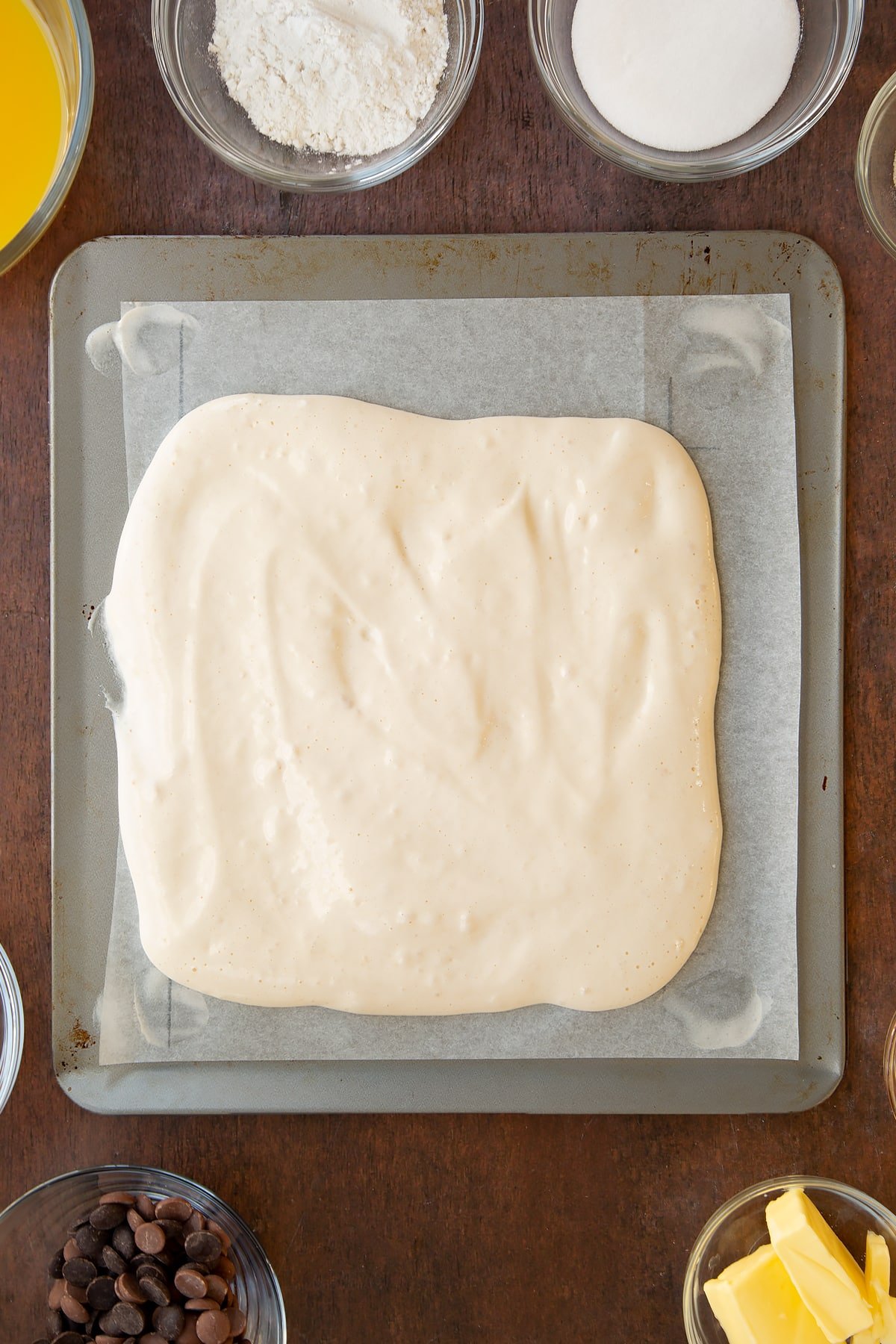
Bake for 8 minutes until risen, golden and just firm to the touch. Slide the paper onto a wire rack for 15 minutes to cool completely.
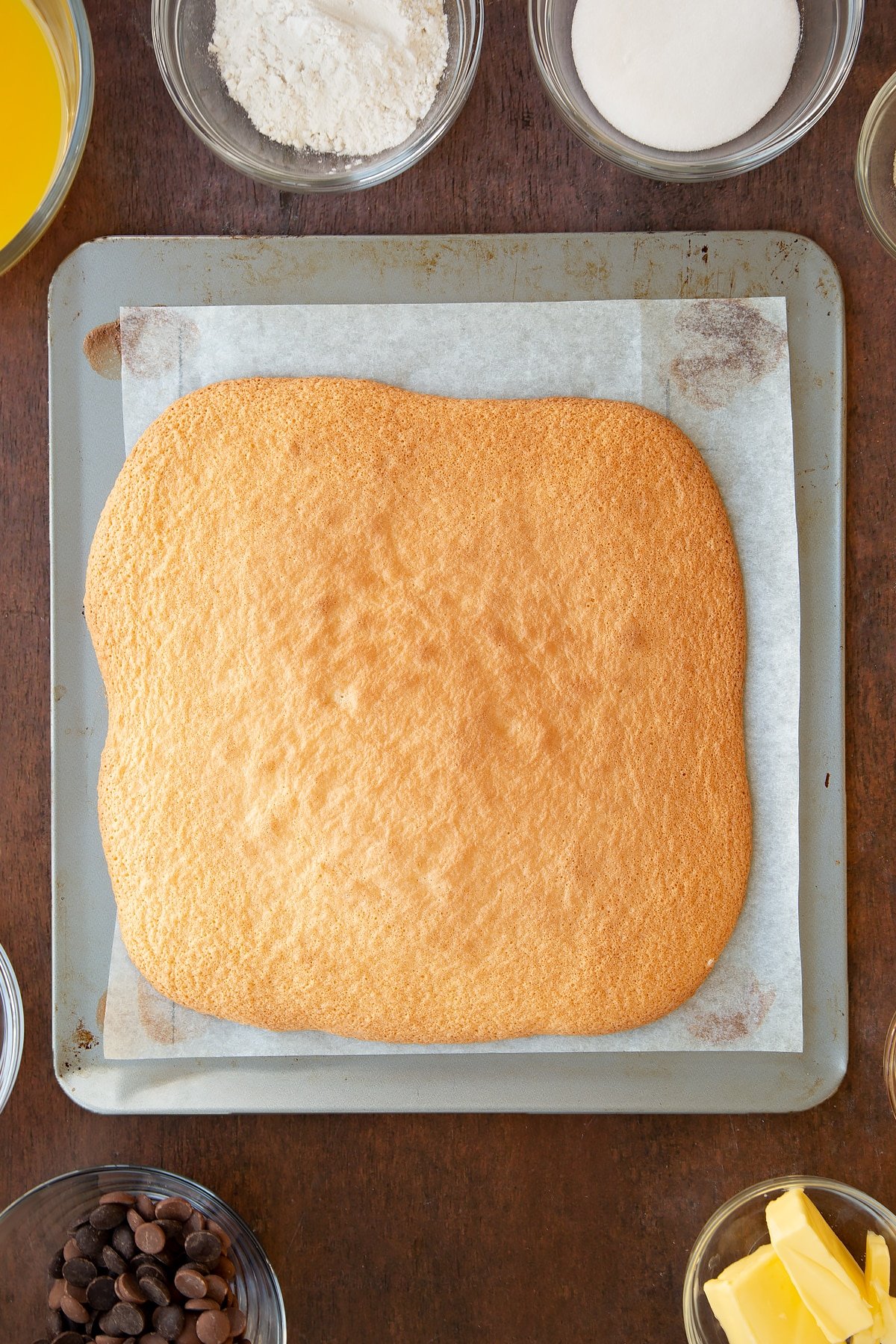
Once the sponge is cold, cut it out where the square guide is. If you can’t see where to cut, you can flip the paper over carefully and trim with sharp scissors before flipping back.
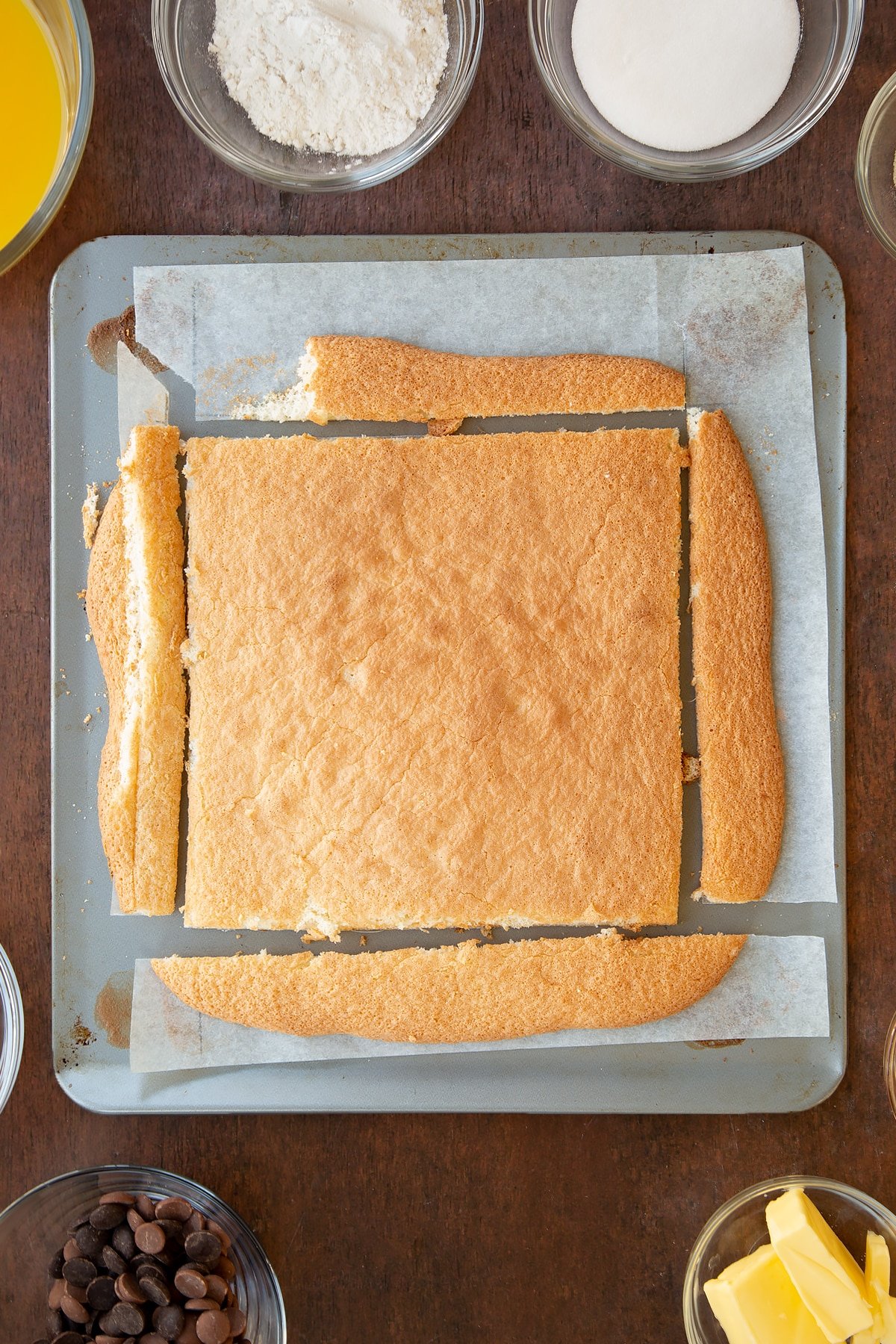
Fit the sponge snugly inside the base of the tin and set aside.
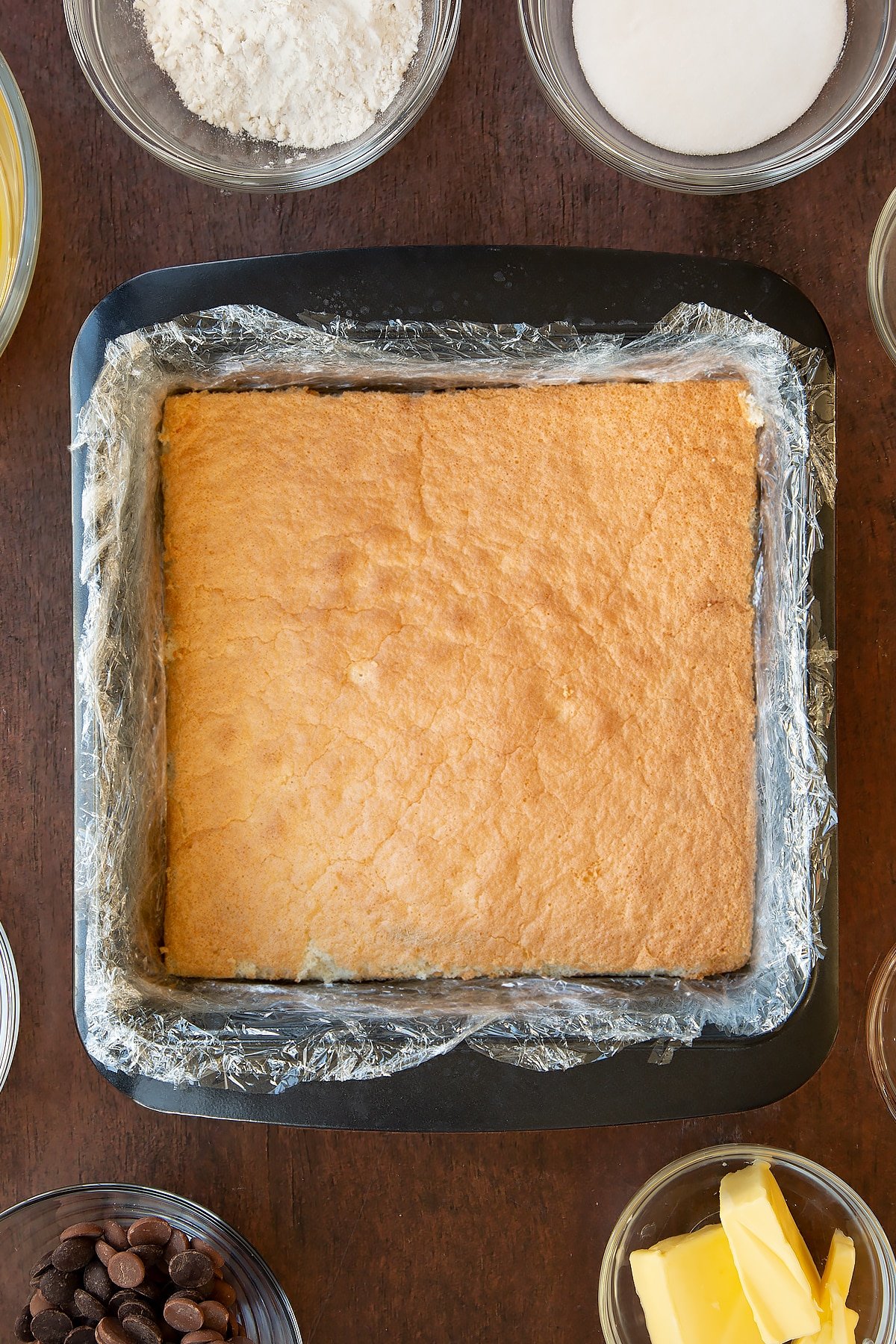
Make the jelly
Measure 150ml (1/4 pt) of steam hot (but not boiling) water into a large heatproof jug and sprinkle the gelatine on top.
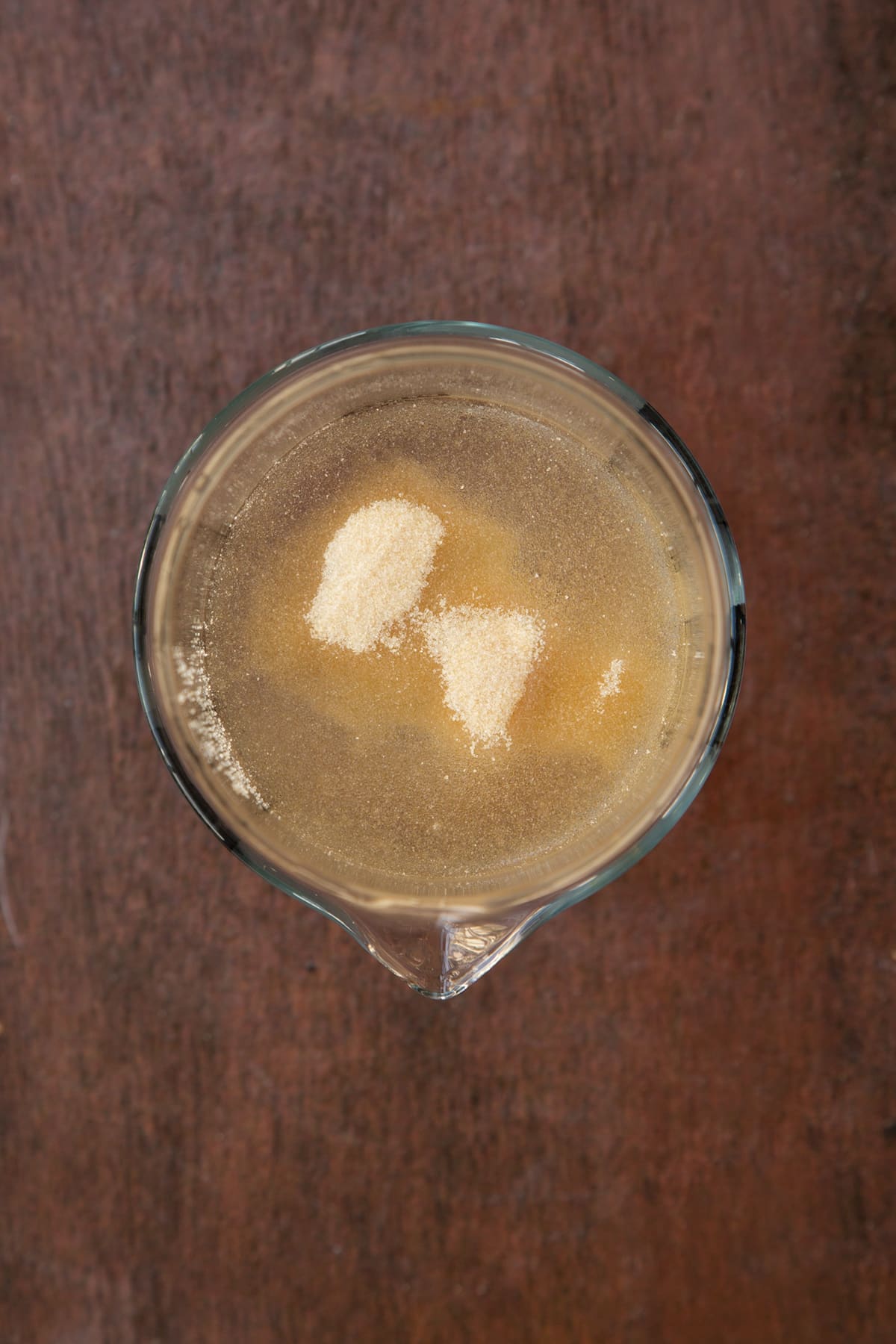
Stir gently until the gelatine dissolves.
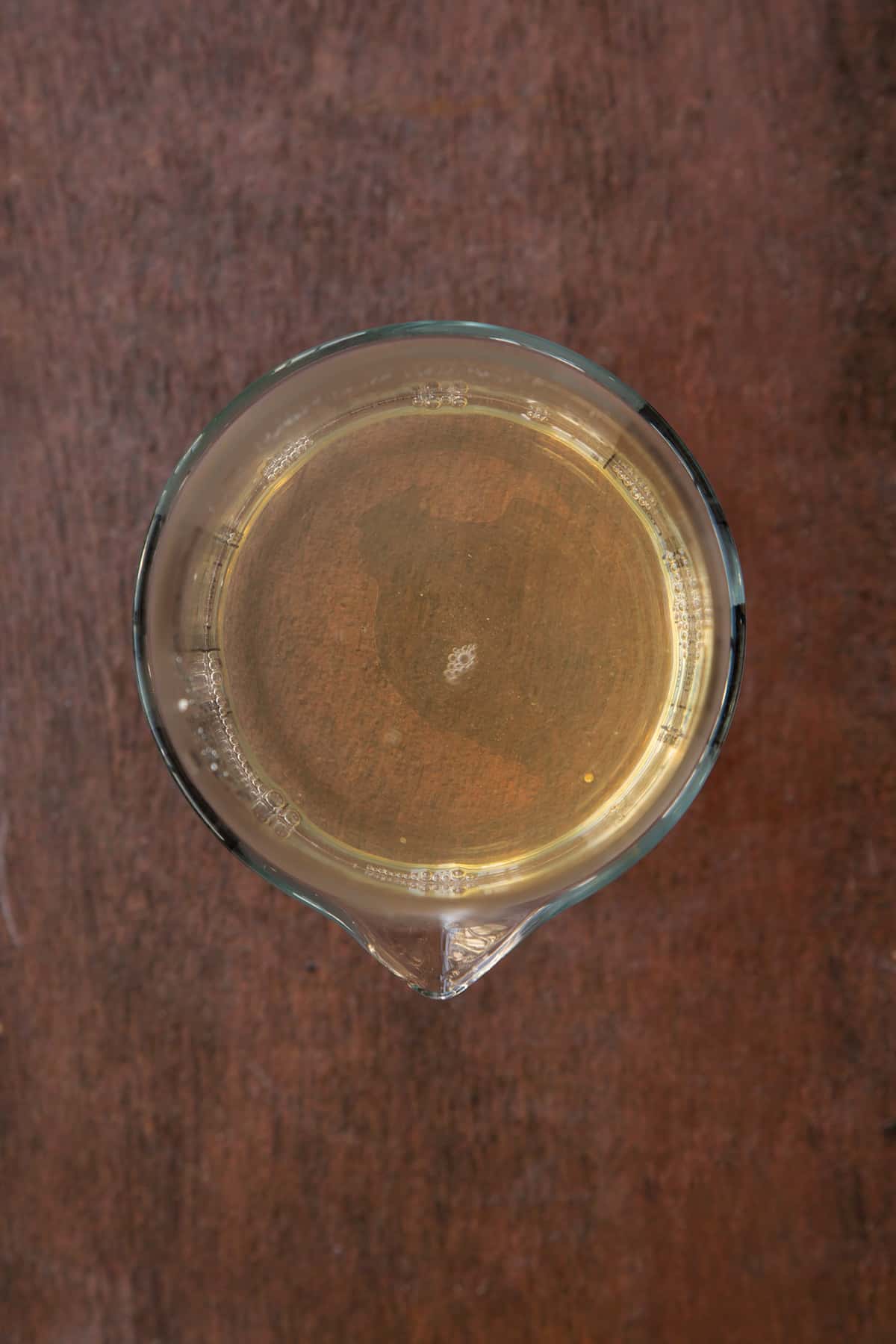
If your jug is big enough, add the orange juice and sugar. If not, transfer everything to a bowl. Gently stir together until the sugar grains have dissolved.
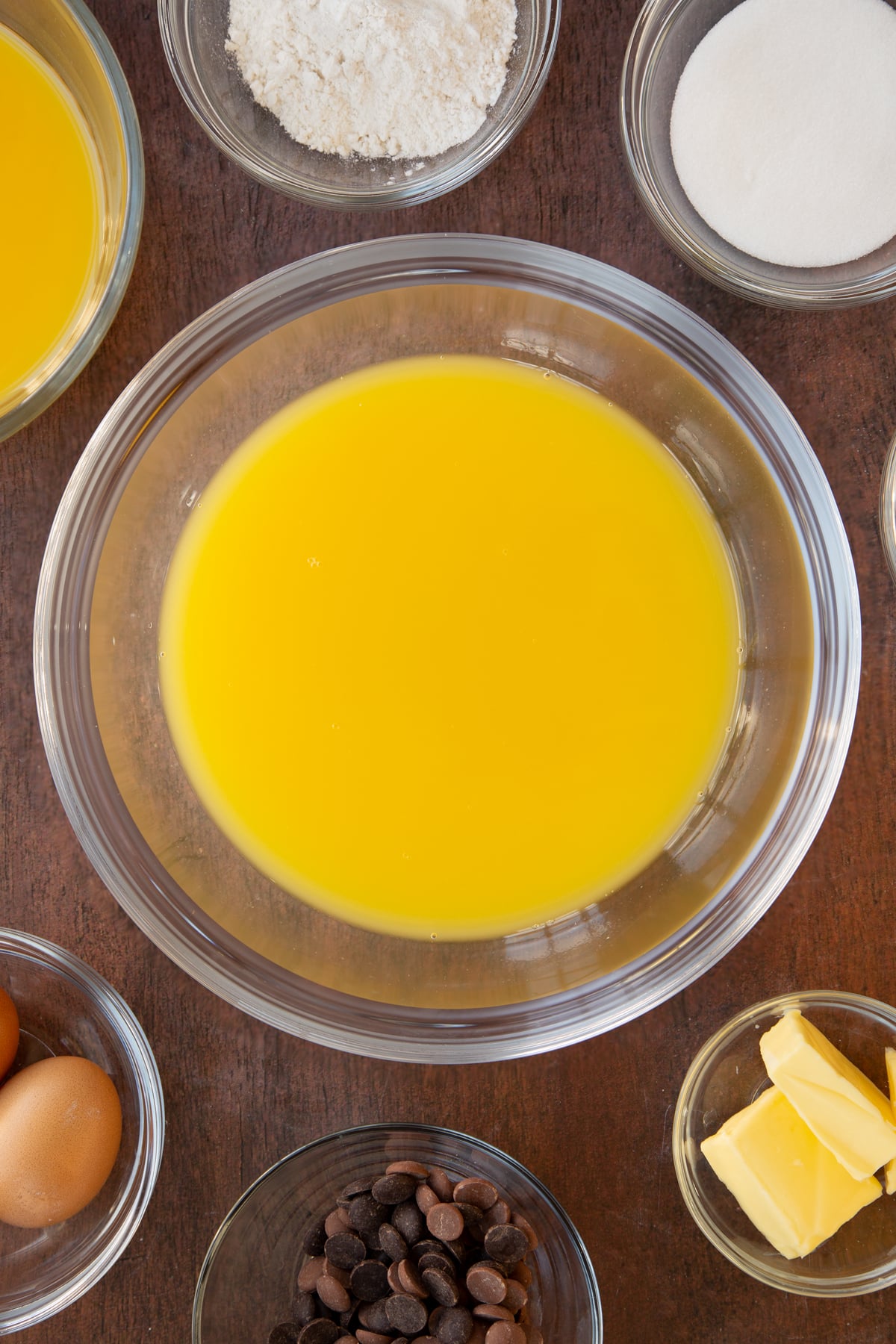
Leave to cool until just on the point of setting - you should see that it is just starting to set at the sides) then pour the jelly over the sponge base.
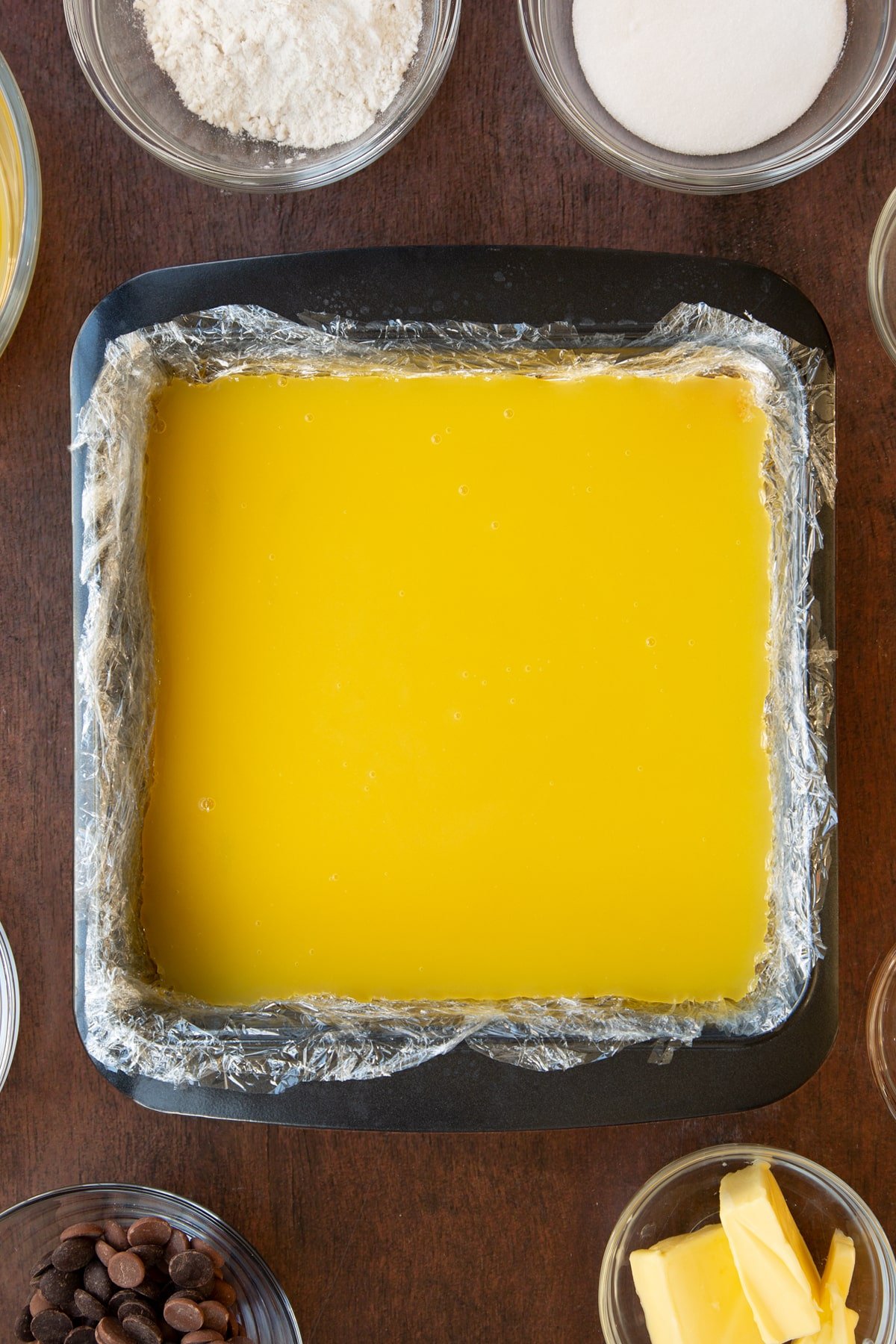
Chill for at least 2 hours to set firmly.
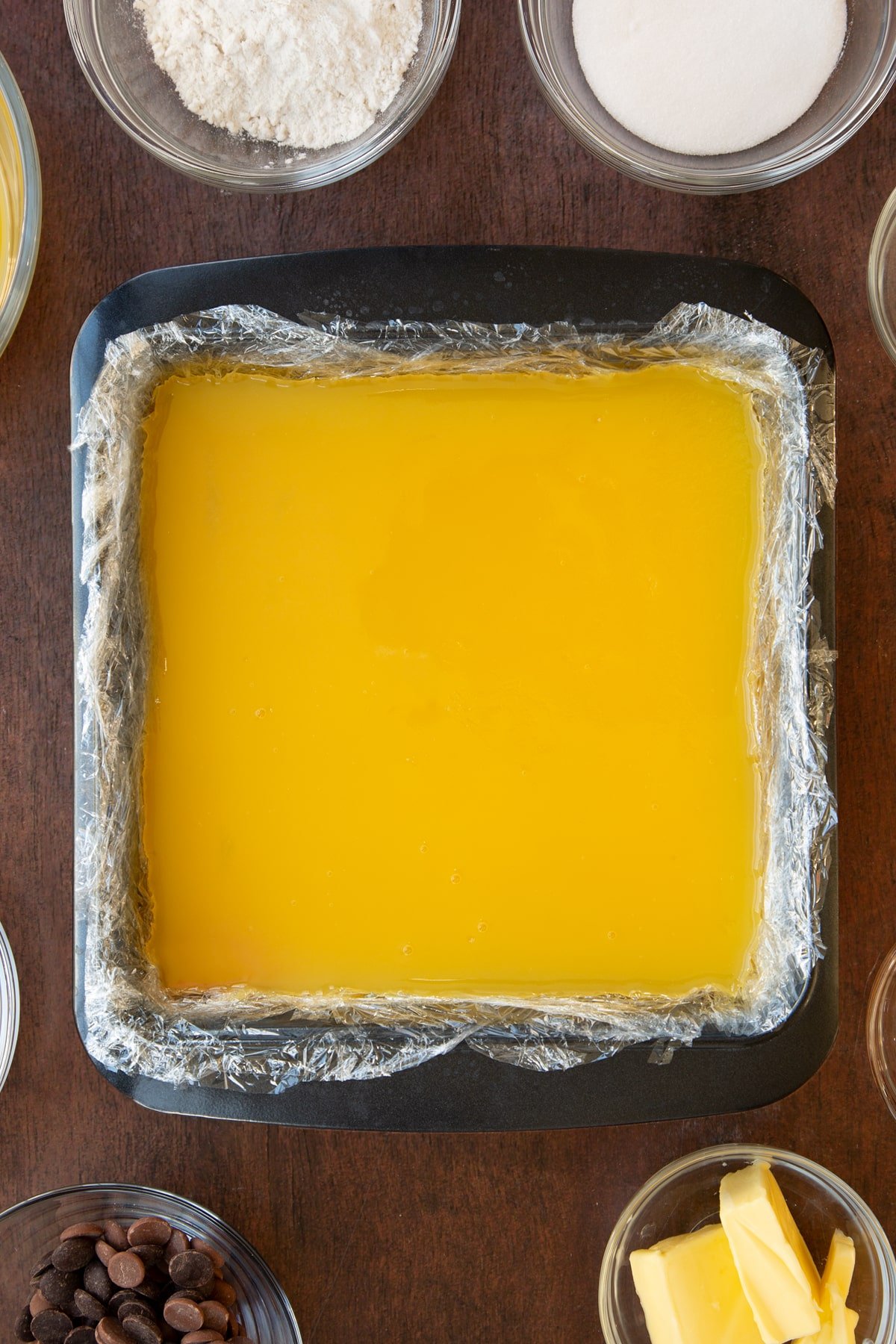
Make the chocolate topping
Put the dark chocolate, milk chocolates, butter and 2 tbsp water in a bowl.
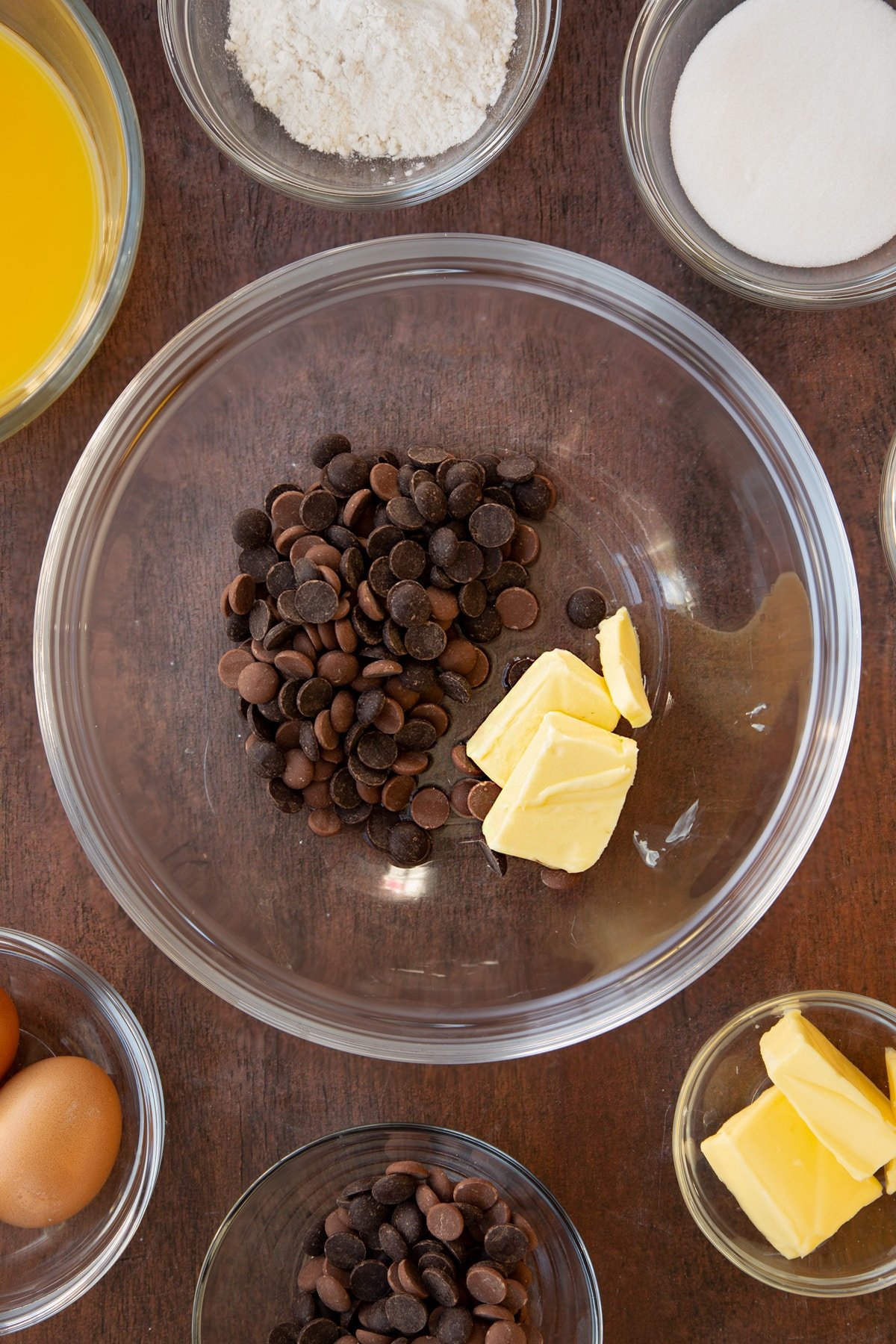
Microwave for 15 seconds, stir gently then microwave for another 15 seconds, continuing until everything is just melted together. Take care not to overheat the chocolate as it may seize. Allow to cool for at least 10 minutes until it doesn’t feel warm to the touch - you don’t want to melt your jelly!
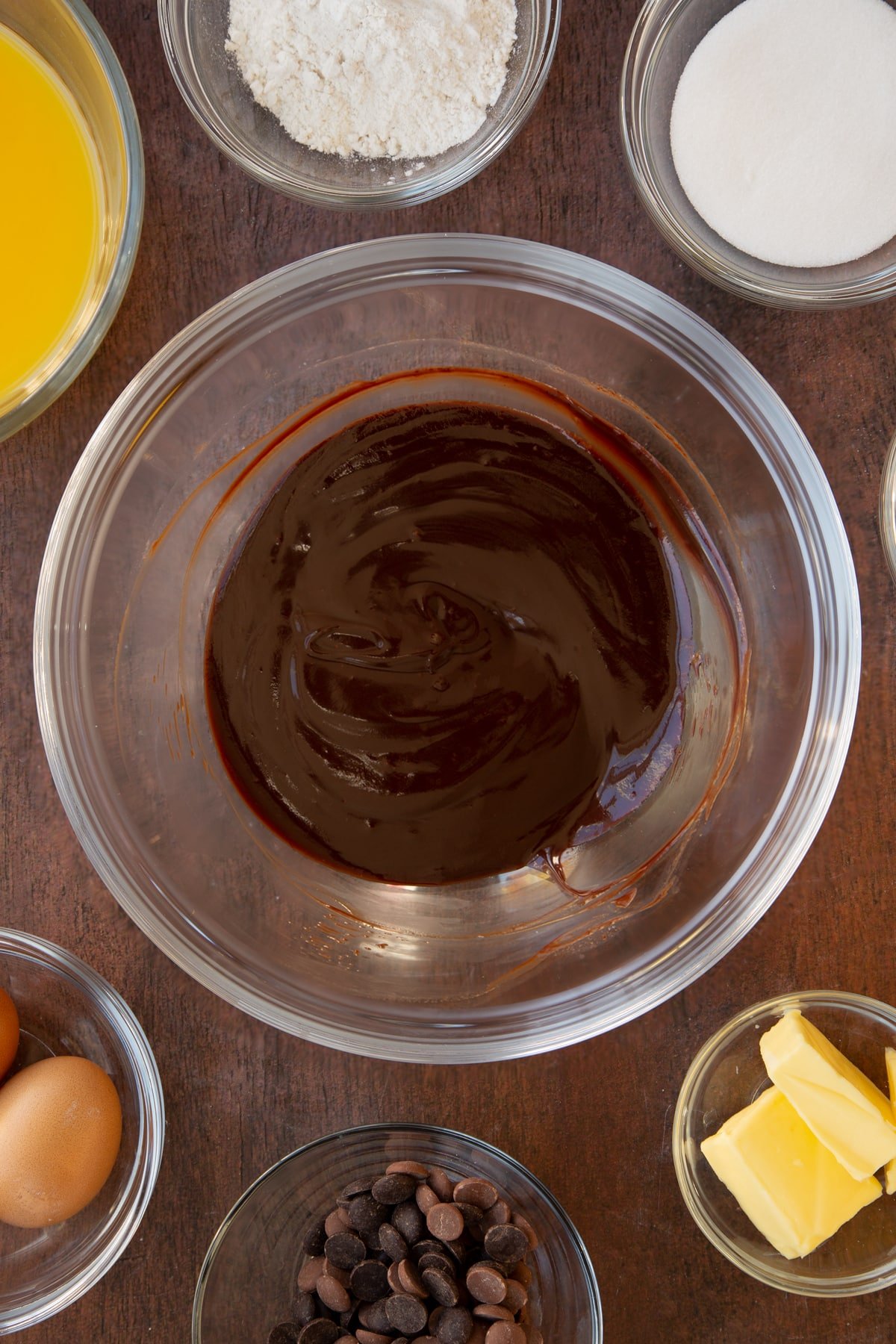
Spoon the chocolate over the set orange jelly and level off - it will set quickly as it touches the chilled jelly.
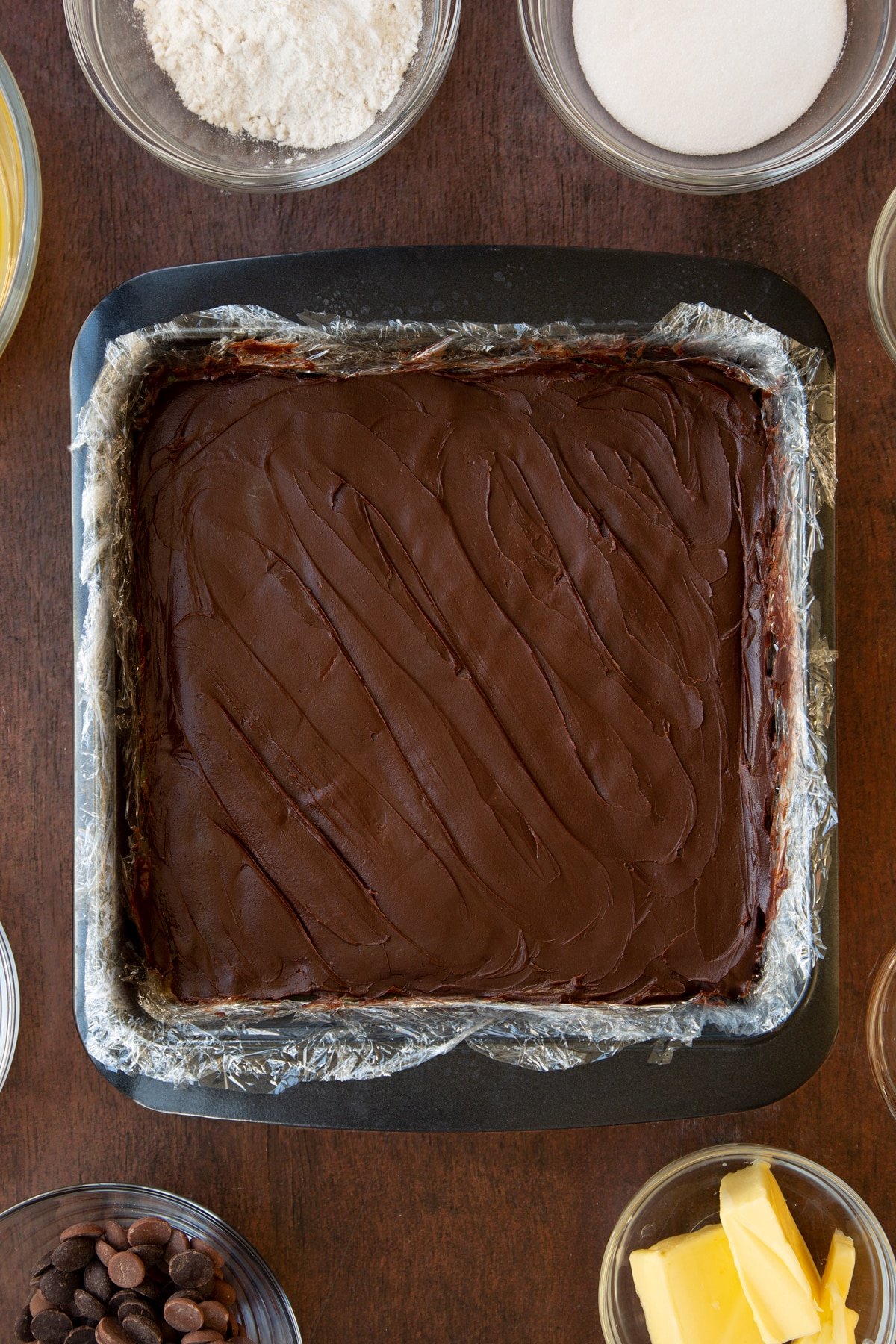
Place in the fridge for 30 minutes to firm up.
To slice and serve
To remove the cake from the tin, place a light board lined with baking paper or clingfilm on top of the tin, then invert it so that the cake drops out. Peel the clingfilm off the backing, then place another light board on top and gently invert the cake back the right way up.
Since the chocolate is firm and the jelly wobbly, this cake can be tricky to slice. To do so neatly, Sit a sharp knife in a bowl of hot water. Wipe the knife dry and score a 4x4 pattern, just cutting through the chocolate layer. Reward and wipe the knife as necessary.
Now, allowing your knife to cool, follow the scored pattern to cut through the jelly and cake layers and you’ll have beautiful little Jaffa Cake traybake bites to enjoy.

Print this Jaffa Cake traybake recipe
Jaffa Cake Traybake Recipe
Ingredients
For the sponge
- 2 medium free range eggs
- 75 g (¼ cup) white caster sugar (superfine sugar)
- 1 tsp vanilla extract
- 50 g (⅓ cup) plain white flour (all purpose flour)
For the orange jelly
- 12 g (4 tsp) powdered gelatine
- 50 g (⅓ cup + 2 tbsp) white caster sugar (superfine sugar)
- 350 ml (1⅓ cup + 2 tbsp) fresh orange juice
To decorate
- 50 g (2 oz) dark chocolate 70% (bittersweet)
- 50 g (2 oz) milk chocolate
- 50 g (½ stick) unsalted butter
Equipment
- Square 20cm (8") nonstick cake tin
- Ruler
- Pencil
- Clingfilm
Instructions
Make the sponge base
- Take a piece of baking paper and draw a 20cm (8inch) square onto it using a ruler for accuracy. Flip the paper over (so that you don't get pencil marks on the sponge) and place on a baking tray.
- Line an 18cm (7inch) square tin with a double layer of cling film.
- Preheat the oven to 200C (180C fan / 390F).
- Put the eggs and caster sugar in a large bowl. Using electric beaters, whisk them together until thick, pale and creamy. This will take about 5 minutes with electric beaters.
- Add the vanilla, then sift the flour on top. Using a silicone spatula or large metal spoon, fold the flour into the egg mixture.
- Immediately pour the sponge mix onto the lined baking sheet and gently spread to cover the square you drew.
- Bake for 8 minutes until risen, golden and just firm to the touch. Slide the paper onto a wire rack for 15 minutes to cool completely.
- Once the sponge is cold, cut it out where the square guide is. If you can’t see where to cut, you can flip the paper over carefully and trim with sharp scissors before flipping back.
- Fit the sponge snugly inside the base of the tin and set aside.
Make the jelly
- Measure 150ml (¼ pt) of steam hot (but not boiling) water into a large heatproof jug and sprinkle the gelatine on top. Stir gently until the gelatine dissolves.
- If your jug is big enough, add the orange juice and sugar. If not, transfer everything to a bowl. Gently stir together until the sugar grains have dissolved.
- Leave to cool until just on the point of setting - you should see that it is just starting to set at the sides) then pour the jelly over the sponge base.
- Chill for at least 2 hours to set firmly.
Make the chocolate topping
- Put the dark chocolate, milk chocolates, butter and 2 tbsp water in a bowl. Microwave for 15 seconds, stir gently then microwave for another 15 seconds, continuing until everything is just melted together. Take care not to overheat the chocolate as it may seize. Allow to cool for at least 10 minutes until it doesn’t feel warm to the touch - you don’t want to melt your jelly!
- Spoon the chocolate over the set orange jelly and level off - it will set quickly as it touches the chilled jelly.
- Place in the fridge for 30 minutes to firm up.
To slice and serve
- To remove the cake from the tin, place a light board lined with baking paper or clingfilm on top of the tin, then invert it so that the cake drops out. Peel the clingfilm off the backing, then place another light board on top and gently invert the cake back the right way up.
- Since the chocolate is firm and the jelly wobbly, this cake can be tricky to slice. To do so neatly, Sit a sharp knife in a bowl of hot water. Wipe the knife dry and score a 4x4 pattern, just cutting through the chocolate layer. Reward and wipe the knife as necessary.
- Now, allowing your knife to cool, follow the scored pattern to cut through the jelly and cake layers and you’ll have beautiful little Jaffa Cake traybake bites to enjoy.
Video
Nutrition
This was originally a commissioned post for Dr. Oetker, with adaptations since original publication in 2015.
If you enjoyed this recipe then you'll likely also love my easy apple pear crumble and my delicious Creme Egg scotch eggs.
Pin this Jaffa Cake traybake recipe
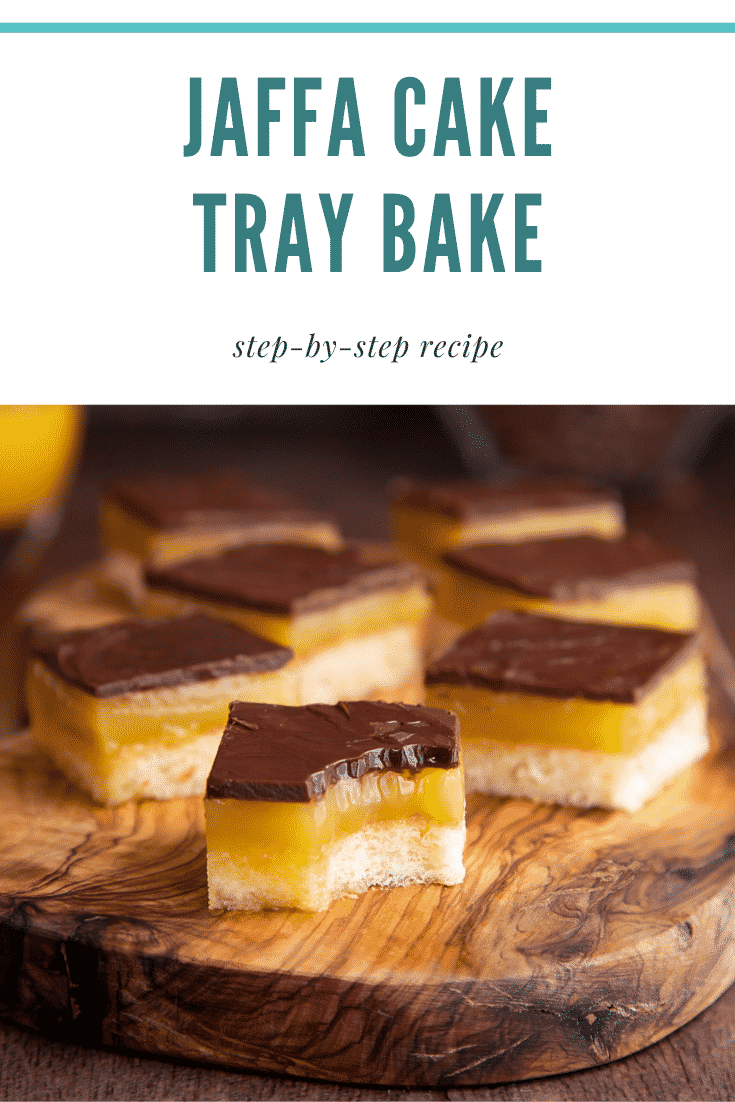
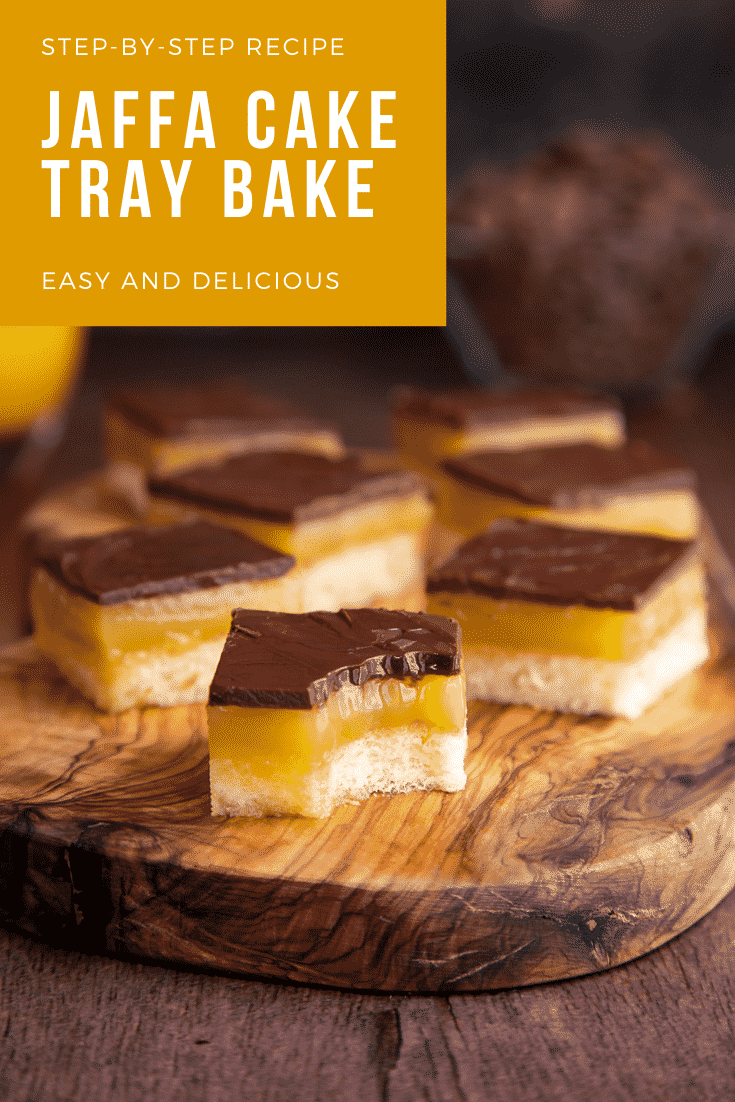
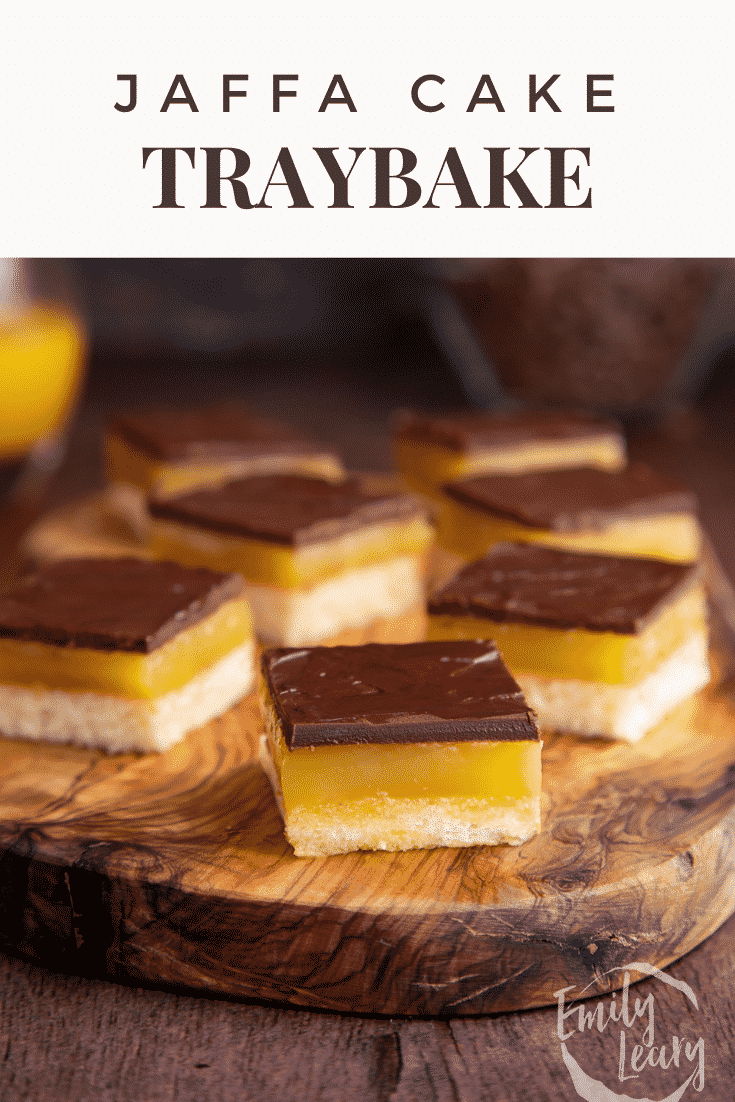
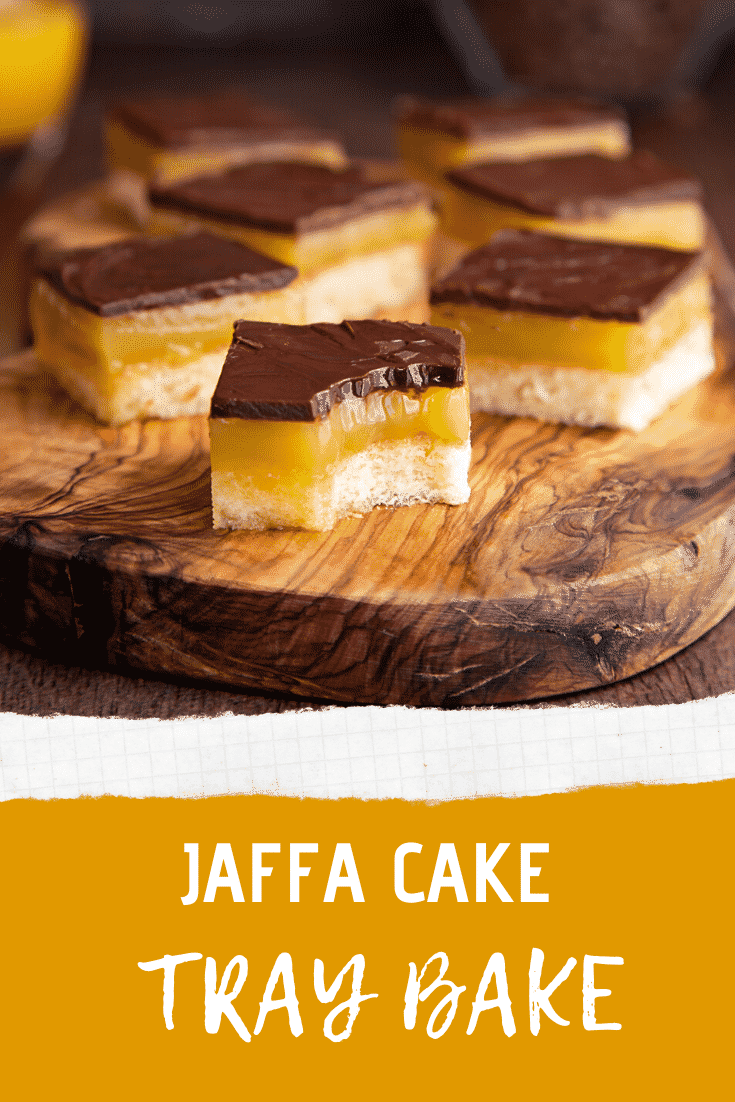
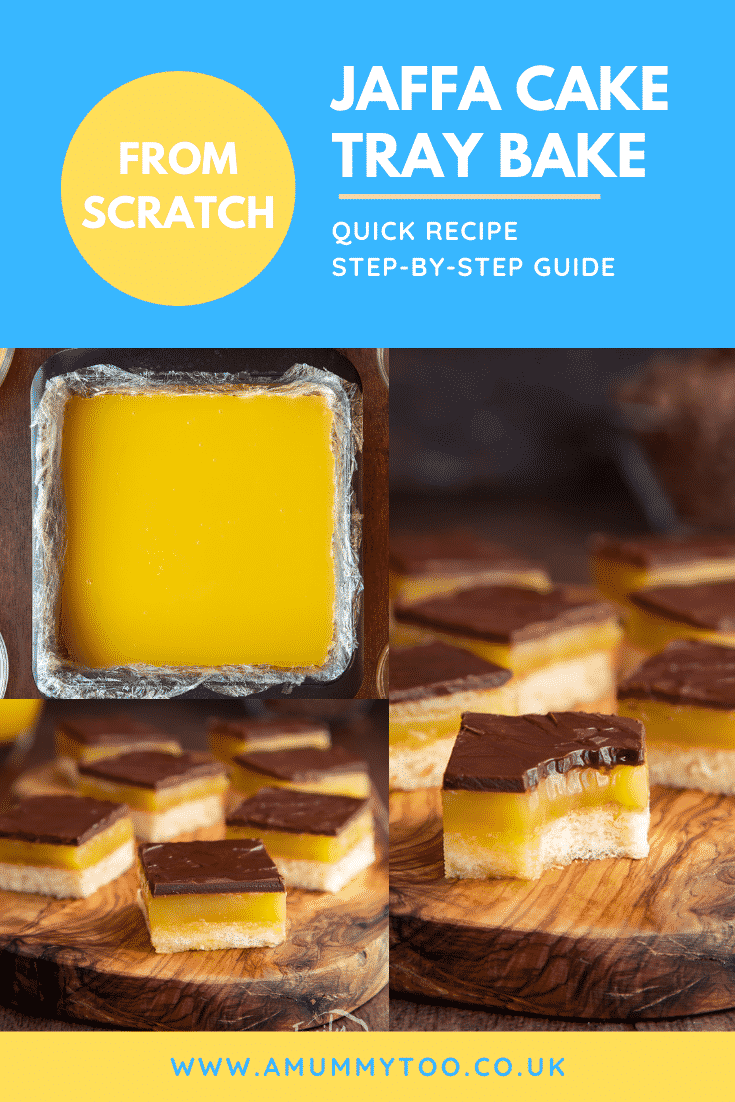
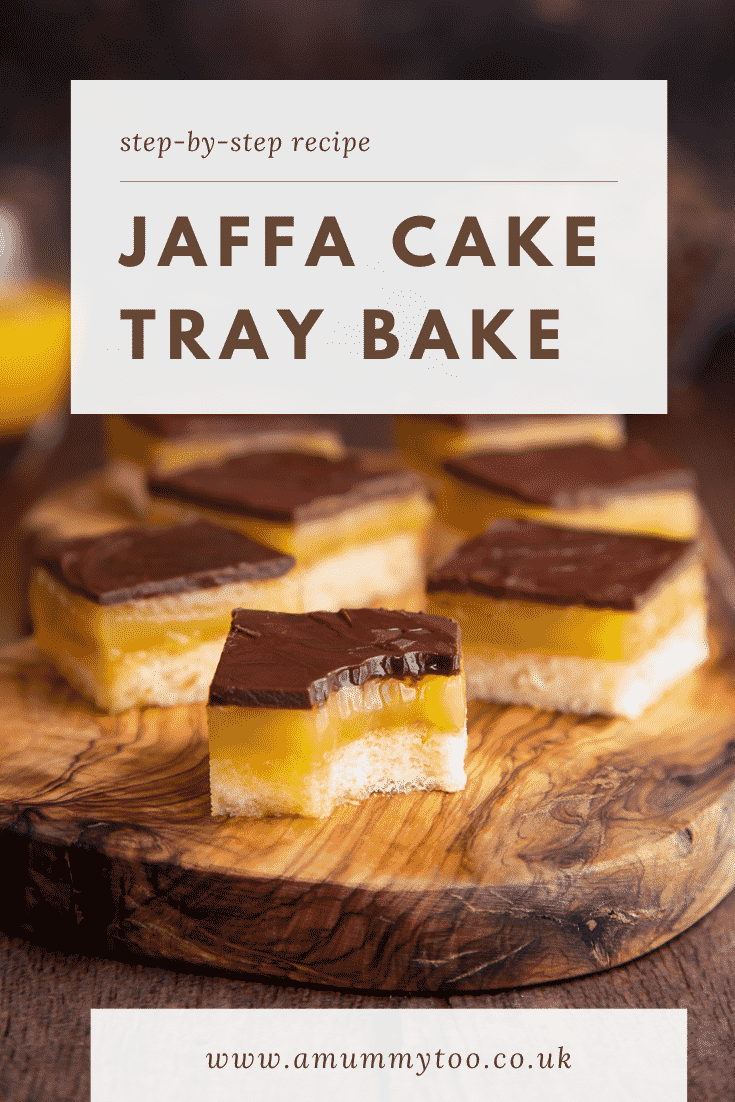
More chocolate orange recipes to try
Have you got my book?

'This is a great kids cookery book. Emily is a star' - Simon Rimmer
'The book I'd like to force into any mother's kitchen' - Prue Leith
"A fab book with a plan." - Jane Devonshire, 2016 Masterchef UK winner
'Emily has managed to combine her mummy knowledge and passion for food to make a truly helpful and brilliant cookbook' - Priya Tew, RD, BSc (Hons), Msc
Get Your Kids to Eat Anything is an achievable 'how to' for parents in the battle to overcome picky eating and 'make new the norm'. Emily Leary's unique 5-phase programme looks at the issue of 'fussy eating' in a holistic way that links imagination with food, and which situates parents alongside - not in opposition to - their children.
.

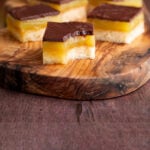
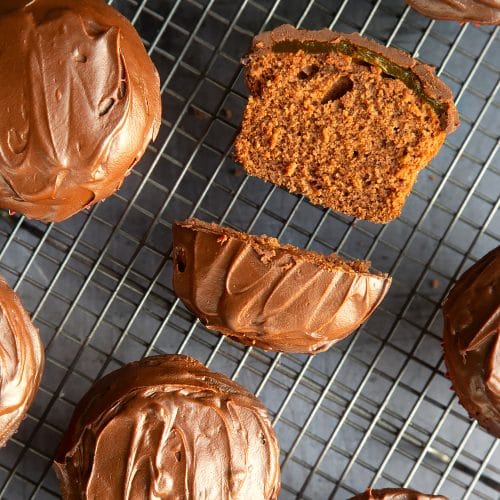
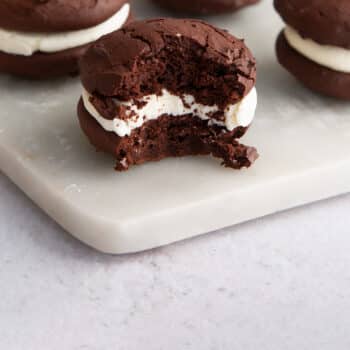
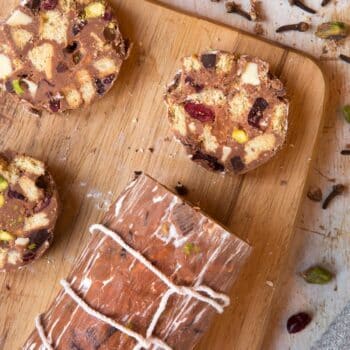
Emily says
This looks like a lot of fun - to make and to eat. The kids will love it, thanks!
Vicki Montague - The Free From Fairy says
Oh my word! What a fabulous recipe and lovely photos! This is like giant jaffa cakes and who doesn't love a jaffa cake?!!
Corina says
I love the sound of these with the orange jelly layer. They remind me of my childhood even though I don't think I've ever eaten anything quite like them!
Angela / Only Crumbs Remain says
This looks lovely, I'm going to have to give this a try. Pinning it!
Angela x
rebecca beesley says
i've always been too scared to use gelatin yet i have a pack sitting in the cupboard - must try this at some point! x
Torn Clark says
Week 2 and 4 were awesome, but this one look special! Perfect bouncy pieces of sweetness :)
Kate - gluten free alchemist says
Yay!! Jaffa Cake!! My favourite xxx
Gareth Mear says
They look so tasty , I would be a fool not to try and recreate this, great post :)
child benefit number says
If you have sweet tooth, you definitely want to bake one for yourself! Just looking at the pictures, my mouth waters.
jenny paulin says
mmmmmmmmm
mmmmmmmm
mmmmmmm
that is all x